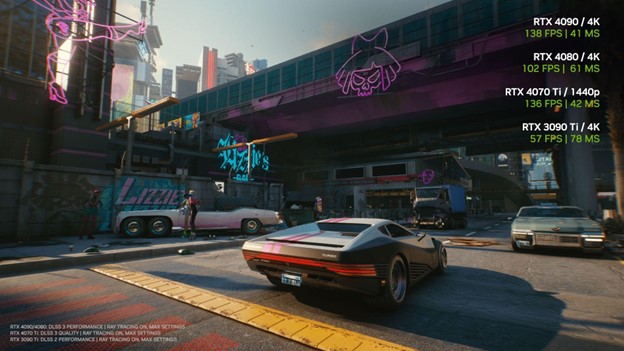Analyst reports. Academic papers. Ph.D. programs. There are a lot of places you can go to get a glimpse of the future. But the best place might just be El Coyote Cojo, a whiskey-soaked dive bar that doesn’t exist in real life.
Fire up Cyberpunk 2077 and you’ll see much more than the watering hole’s colorful clientele. You’ll see refractions and reflections, shadows and smoke, all in the service of creating more than just eye candy — each element works in tandem with the game’s expansive and engaging story.
Patching In: Cyberpunk 2077’s DLSS 3 Upgrade
It’s a tale that gets more mesmerizing with every patch — the updates game developers periodically release to keep their games at the cutting edge. Today’s addition brings NVIDIA DLSS 3, the latest in neural graphics.
DLSS 3 is a package that includes a number of sophisticated technologies. Combining DLSS Super Resolution, all-new DLSS Frame Generation, and NVIDIA Reflex, running on the new hardware capabilities of GeForce RTX 40 Series GPUs, DLSS 3 multiplies performance while maintaining great image quality and responsiveness.
The performance uplift this delivers lets PC gamers experience more of Cyberpunk 2077’s gritty glory. And it sets the stage for the pending Ray Tracing Overdrive Mode, an update that will escalate the game’s ray tracing, a technique long used to create blockbuster films and enhance the game’s already-incredible visuals.
The gaming press — perhaps the most brutal critics of the visual arts — are already raving about DLSS 3.
“I’m deeply in love with DLSS with Frame Generation,” gushes PC Gamer. “DLSS 3 is incredible, and NVIDIA’s tech is undeniably a selling point for the [GeForce RTX] 4080,” asserts PCGamesN. “[I]t’s a phenomenal achievement in graphics performance,” states Digital Foundry.
Twenty-one games now support DLSS 3, including Dying Light 2 Stay Human, Hitman 3, Marvel’s Midnight Suns, Microsoft Flight Simulator, Portal with RTX, The Witcher 3: Wild Hunt and Warhammer 40,000: Darktide. More are coming, including Atomic Heart, ILL SPACE and Warhaven.
Playing with the Future
There are many tales on the increasingly immersive streets of Cyberpunk 2077’s Night City, but the one even non-gamers should pay attention to the story behind these stories: gaming as a proving ground for the technologies that will shape the future Cyberpunk 2077 is simulating right before our eyes.
This is the best of the best. CD PROJEKT RED is known for supporting its flagship titles like Cyberpunk 2077 and The Witcher 3: Wild Hunt for extended periods of time with a variety of patches that take advantage of modern hardware. It has earned a reputation as a game development studio that embraces emerging technologies.
That makes its games more than a cultural phenomenon. They’re a technology-proving ground, a position held over the past two decades by a string of titles revered by gamers, such as Crysis, Metro and Far Cry.
PC Games Unleash Global Innovation
Building digital worlds such as these is the hard computing problem — the meanest streets in our increasingly digital world — out of which the parallel computing engines that are GPUs emerged.
A decade ago, GPUs sparked the deep-learning revolution that has upended trillion-dollar industries around the world, one that continues with the latest advancements in generative AI such as ChatGPT and Dall-E that have erupted over the past month into a global cultural sensation.
It’s a case study in the disruptive innovations Harvard Business School Professor Clayton Christensen identified as lurking in unexpected places.
DLSS brings that revolution full circle, using the same deep-learning techniques harnessed for everything from cutting-edge science to self-driving cars to advance the visual quality of games.
Trained on NVIDIA’s supercomputers, DLSS enhances a new generation of games that demand ever more performance. And the use of DLSS 3 is just one example of this benchmark game’s innovations — innovations woven into the texture of the game’s storytelling.
CD PROJEKT RED uses DirectX Ray Tracing, for example, a lighting technique that emulates the way light reflects and refracts in the real world to provide a more believable environment than what’s typically seen using static lighting in more traditional games.
The game uses several ray-tracing techniques to render a massive future city at incredible levels of detail. The current version of the game uses ray-traced shadows, reflections, diffuse illumination and ambient occlusion.
And if you turn on “Psycho mode” in the game’s ray-traced lighting settings, you’ll even see ray-traced global illumination as sunlight bounces realistically around the scene.
Cyberpunk 2077’s Visual Storytelling Packs a Punch
The result of all these features is a visually stunning experience that complements the world’s story and tone: sprawling cityscapes that use subtle shadows to define depth, districts are bathed in neon lights, and windows, mirrors and puddles glistening with accurate reflections.

With realistic shadows and lighting and the added performance of NVIDIA DLSS 3, no other platform will compare to the Cyberpunk 2077 experience on a GeForce RTX-powered PC.
But that’s just part of the bigger story.
Games like these offer a window into the kind of visual capabilities now at the fingertips of architects and designers. It’s a taste of the simulation capabilities being put to work by engineers at NASA and Lawrence Livermore Labs. And it shows what’s possible in the next-generation environments for digital collaboration and simulation now being harnessed at scale by manufacturers such as BMW.
So muscle the geek in your life aside from the PC for an evening, grab the latest patch for Cyberpunk 2077 and a GeForce 40 Series GPU and gawk at the game’s abundance of power and potential, put on display right in front of your face.
It’s where we’ll see the future first, and that future is looking better than ever.
Find out more on GeForce.com.
